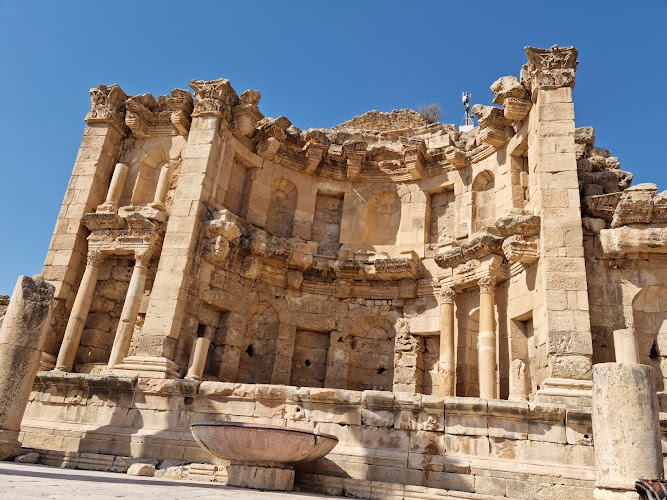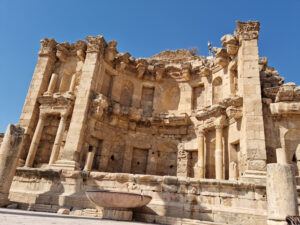
About Archaeological Site of Jerash
Description
Picture yourself walking through the remarkably preserved streets of an ancient Roman city, where your footsteps echo against the same limestone pavements that chariots once rolled over. That's exactly what you'll experience at Jerash, one of the world's most spectacular archaeological sites. And trust me, as someone who's explored quite a few Roman ruins across the Mediterranean, this place leaves me speechless every time. The scale of this ancient metropolis is mind-blowing - we're talking about an entire city that's been frozen in time since the Roman era. The architecture here tells stories of triumph, daily life, and artistic achievement that span several civilizations. Ya know what really gets me? The fact that about 90% of the ancient city still lies unexcavated beneath the soil. Just imagine what secrets are still waiting to be discovered!Key Features
• The iconic Hadrian's Arch, standing proud at 11 meters high - built to welcome Emperor Hadrian himself (fancy, right?) • The jaw-dropping Hippodrome, where chariot races and gladiatorial contests once had crowds roaring • The oval-shaped Forum, surrounded by those gorgeous ionic columns that seriously make for the perfect photo op • The Temple of Artemis, which honestly still gives me goosebumps with its massive columns and intricate details • The incredibly well-preserved South Theater, where you can still test the amazing acoustics • The Cardo Maximus, a colonnaded street stretching over 600 meters - I always imagine the ancient shops and bustling trade that once happened here • Two massive temples dedicated to Zeus and Artemis (because one temple just wasn't enough!) • The Nymphaeum, an ornate public fountain that's still impressive after all these centuriesBest Time to Visit
Spring (March to May) and autumn (September to November) are absolute perfection for exploring Jerash. The temperatures hover around a comfortable 20-25°C (68-77°F), and the sun isn't trying to cook you alive like it does in summer. I learned this the hard way during my first visit in July - boy, was that a sweaty adventure! Winter can be surprisingly chilly and sometimes rainy, but if you don't mind bundling up, you'll get some amazing photos with dramatic cloudy skies. Plus, tourist crowds are way thinner during these months. Summer? Well, unless you're a fan of exploring ancient ruins in 35°C+ (95°F+) heat, maybe save your visit for another season.How to Get There
Getting to Jerash is pretty straightforward, especially from Amman. You've got several options, depending on your adventure style and budget. The most common way is to hop on a public bus from Amman's North Bus Station - it's cheap and cheerful, though it might test your patience a bit. Taxis are another option, and while they're pricier, they're definitely more comfortable. If you're feeling fancy (or just prefer having everything organized), tons of tour companies run day trips from Amman. They usually combine Jerash with other nearby sites, which is pretty sweet if you're short on time. And if you're the independent type who likes to do things your own way, renting a car is totally doable - the roads are decent, and it's about a 45-minute drive from Amman.Tips for Visiting
Let me share some hard-earned wisdom from my multiple visits to this incredible site. First off, wear comfortable shoes - and I mean really comfortable. You'll be doing a lot of walking on uneven surfaces, and those ancient stones can be slippery. I once made the mistake of wearing my cute new sandals... never again! Bring plenty of water (trust me on this one), and pack some snacks. While there are vendors around, they're mainly outside the site, and you might not want to interrupt your exploration. A hat and sunscreen are absolute must-haves - there's not much shade among those beautiful ruins. Here's a pro tip that most guidebooks won't tell you: start your visit at the Hippodrome end and work your way up. This way, you'll be walking uphill while you're still fresh and energetic. Plus, the lighting for photos is usually better in this direction during the morning hours. Oh, and don't rush! Give yourself at least 3-4 hours to properly explore. The site is huge, and there's something fascinating around every corner. I'd say morning visits are best - not just for the cooler temperatures, but also because the light makes those limestone columns glow like they're made of gold. Consider hiring a local guide - they know all sorts of fascinating stories and historical details that you might miss otherwise. And some of them can point out cool architectural features that most visitors walk right past. Just make sure to agree on the price beforehand. One last thing - bring cash! Credit cards aren't always accepted at the ticket office, and you might want to buy some local crafts or refreshments from the vendors outside the site.Description
Picture yourself walking through the remarkably preserved streets of an ancient Roman city, where your footsteps echo against the same limestone pavements that chariots once rolled over. That’s exactly what you’ll experience at Jerash, one of the world’s most spectacular archaeological sites. And trust me, as someone who’s explored quite a few Roman ruins across the Mediterranean, this place leaves me speechless every time.
The scale of this ancient metropolis is mind-blowing – we’re talking about an entire city that’s been frozen in time since the Roman era. The architecture here tells stories of triumph, daily life, and artistic achievement that span several civilizations. Ya know what really gets me? The fact that about 90% of the ancient city still lies unexcavated beneath the soil. Just imagine what secrets are still waiting to be discovered!
Key Features
• The iconic Hadrian’s Arch, standing proud at 11 meters high – built to welcome Emperor Hadrian himself (fancy, right?)
• The jaw-dropping Hippodrome, where chariot races and gladiatorial contests once had crowds roaring
• The oval-shaped Forum, surrounded by those gorgeous ionic columns that seriously make for the perfect photo op
• The Temple of Artemis, which honestly still gives me goosebumps with its massive columns and intricate details
• The incredibly well-preserved South Theater, where you can still test the amazing acoustics
• The Cardo Maximus, a colonnaded street stretching over 600 meters – I always imagine the ancient shops and bustling trade that once happened here
• Two massive temples dedicated to Zeus and Artemis (because one temple just wasn’t enough!)
• The Nymphaeum, an ornate public fountain that’s still impressive after all these centuries
Best Time to Visit
Spring (March to May) and autumn (September to November) are absolute perfection for exploring Jerash. The temperatures hover around a comfortable 20-25°C (68-77°F), and the sun isn’t trying to cook you alive like it does in summer. I learned this the hard way during my first visit in July – boy, was that a sweaty adventure!
Winter can be surprisingly chilly and sometimes rainy, but if you don’t mind bundling up, you’ll get some amazing photos with dramatic cloudy skies. Plus, tourist crowds are way thinner during these months. Summer? Well, unless you’re a fan of exploring ancient ruins in 35°C+ (95°F+) heat, maybe save your visit for another season.
How to Get There
Getting to Jerash is pretty straightforward, especially from Amman. You’ve got several options, depending on your adventure style and budget. The most common way is to hop on a public bus from Amman’s North Bus Station – it’s cheap and cheerful, though it might test your patience a bit. Taxis are another option, and while they’re pricier, they’re definitely more comfortable.
If you’re feeling fancy (or just prefer having everything organized), tons of tour companies run day trips from Amman. They usually combine Jerash with other nearby sites, which is pretty sweet if you’re short on time. And if you’re the independent type who likes to do things your own way, renting a car is totally doable – the roads are decent, and it’s about a 45-minute drive from Amman.
Tips for Visiting
Let me share some hard-earned wisdom from my multiple visits to this incredible site. First off, wear comfortable shoes – and I mean really comfortable. You’ll be doing a lot of walking on uneven surfaces, and those ancient stones can be slippery. I once made the mistake of wearing my cute new sandals… never again!
Bring plenty of water (trust me on this one), and pack some snacks. While there are vendors around, they’re mainly outside the site, and you might not want to interrupt your exploration. A hat and sunscreen are absolute must-haves – there’s not much shade among those beautiful ruins.
Here’s a pro tip that most guidebooks won’t tell you: start your visit at the Hippodrome end and work your way up. This way, you’ll be walking uphill while you’re still fresh and energetic. Plus, the lighting for photos is usually better in this direction during the morning hours.
Oh, and don’t rush! Give yourself at least 3-4 hours to properly explore. The site is huge, and there’s something fascinating around every corner. I’d say morning visits are best – not just for the cooler temperatures, but also because the light makes those limestone columns glow like they’re made of gold.
Consider hiring a local guide – they know all sorts of fascinating stories and historical details that you might miss otherwise. And some of them can point out cool architectural features that most visitors walk right past. Just make sure to agree on the price beforehand.
One last thing – bring cash! Credit cards aren’t always accepted at the ticket office, and you might want to buy some local crafts or refreshments from the vendors outside the site.
Location
Places to Stay Near Archaeological Site of Jerash
Find Tours in Jerash
Explore More Travel Guides
No reviews found! Be the first to review!


